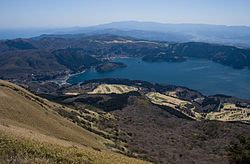Hakone, Kanagawa
|
Hakone 箱根町 |
|||
|---|---|---|---|
| Town | |||

View of Lake Ashi and Hakone Town from Mount Hakone Komagatake
|
|||
|
|||
 Location of Hakone in Kanagawa Prefecture |
|||
| Coordinates: 35°11′N 139°02′E / 35.183°N 139.033°ECoordinates: 35°11′N 139°02′E / 35.183°N 139.033°E | |||
| Country | Japan | ||
| Region | Kantō | ||
| Prefecture | Kanagawa Prefecture | ||
| District | Ashigarashimo | ||
| Area | |||
| • Total | 92.82 km2 (35.84 sq mi) | ||
| Population (June 1, 2012) | |||
| • Total | 13,492 | ||
| • Density | 145/km2 (380/sq mi) | ||
| Time zone | Japan Standard Time (UTC+9) | ||
| - Tree | Yamazakura (Prunus jamasakura) | ||
| - Flower | Hakonebara (Rosa microphylla hirtura) | ||
| - Bird | Woodpecker | ||
| Phone number | 0460-85-7111 | ||
| Address | 256 Yumoto, Hakone-machi, Ashigarashimo-gun, Kanagawa-ken 250-0398 | ||
| Website | Town of Hakone HP | ||
Hakone (箱根町 Hakone-machi?) is a town in Ashigarashimo District in Kanagawa Prefecture, Japan. As of June 2012, the town had an estimated population of 13,492 and a population density of 145 persons per km². The total area was 92.82 km². Hakone has been designated as a Geopark by UNESCO.
Hakone is located in the mountainous far west of the prefecture, on the eastern side of Hakone Pass. Most of the town is within the borders of the volcanically active Fuji-Hakone-Izu National Park, centered on Lake Ashi.
Kanagawa Prefecture
Shizuoka Prefecture
Hakone is the location of a noted Shinto shrine, the Hakone Gongen, which is mentioned in Heian period literature. During the Gempei War, Minamoto no Yoritomo prayed at this shrine for victory over his enemies, after his defeat at the Battle of Ishibashiyama, which was fought in neighboring Manazuru. As with the rest of Sagami Province, the area came under the control of the late Hōjō clan of Odawara during the Sengoku period. After the start of the Edo period, Hakone-juku was a post station on the Tōkaidō highway connecting Edo with Kyoto. It was also the site of a major barrier and official checkpoint on the route known as the Hakone Checkpoint (箱根関所 Hakone sekisho?), which formed the border of the Kantō region. Under the Tokugawa shogunate, all travellers entering and leaving Edo along the Tōkaidō were stopped here by officials. Their travel permits and baggage were examined to enforce Tokugawa laws that restricted the travel of women and weapons.
...
Wikipedia



